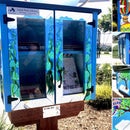Introduction: Dyed Wire Wrapped Gemstone Pendant
Dying metal and stone is so much fun!
Here are instructions for making a rustic wire wrapped pendant and then adding vibrant color with alcohol dyes. If this is a gift, plan ahead - you'll need time for the dyes and sealer to dry. And if you don't have much time, the necklace looks great with or without the added color!
Step 1: What You Need
MATERIALS:
30mm light colored gemstone donut (round with a hole)
2.5 ft of 22 gauge, round, dead soft, copper wire
Alcohol dyes (I have red, yellow, blue)
Thinner/solvent for the dyes
8-14mm copper jump ring (raw, unsealed copper, preferably)
Sealer to protect finish
TOOLS:
Round nose pliers (Other pliers are optional)
Wire cutters
Small brush for dyes
Toothpicks
Latex gloves
Step 2: Get Started
Fold your wire in half and pinch the bend so that it makes a small loop.
Then hook the looped end of the wire through the doughnut hole so that 5 mm of the loop extends above the edge of the donut.
Step 3:
Thread the ends of the wire through the small loop and pull tight. Try not to cross or kink the wire.
Bend the loose wires to the back of the pendant so that they hook around the sides of the small loop.
Step 4: Wrap
Now you can wind the long ends of the wire around the donut. You can go simple and just make a loops. Or you can do something more decorative with the wire like create some swirls or spirals. I went around the doughnut three times on each side and then made some decorative swirls.
Step 5: Embellish
I came up through the back to make my loops. I held both wires together and pressed them against the gemstone while I created the shape. Up to this point I needed no tools except for my cutters.
Remember you can go through to the backside of the doughnut and continue with your design from the other side. Or even design a double-sided pendant.
Make sure you knew leave enough loose wire to secure it back on to the top of the donut.
Step 6:
When you have the wire work the way you like it, bring the loose ends back up to the small loop.
Wind the ends of the wire around the loop, making sure to leave at least 2 mm at the top for the jump ring.
Step 7: Finish the Ends
Either cut the ends short and tuck them in against the stone or use your round nose pliers to make spirals. (If you need instructions for this, please see my basic wire wrapped pendant tutorial.)
Step 8: Alternative Pattern
You can tighten or embellish the fronts of the straight wires by giving a quarter turn with your pliers in the center of each wire.
Step 9: Add a Jump Ring
Step 10: Finish the Wrapping
With your pliers, tighten any wires that seem loose and adjust your design if needed. Then wash your pendant and let it dry fully.
These pendants are ready to wear, if you don't want to add color.
Step 11: Time to Dye
Alcohol dyes work great on stone and metal.
Be forewarned that they are highly concentrated, and being really good dyes, stain everything. That being said, set up in a place that cleans up easily. I use a piece of discarded plastic packaging as my palette.
Put on gloves and set up your workspace. Have the dyes, the solvent, a paintbrush, toothpicks and a rag ready.
Step 12: Dyes
Place a couple of drops of each color on your palette. Don't let them touch. Pour a small amount of thinner in another area or in a small container.
Step 13: Start to Paint
Using toothpicks and/or the paintbrush, start adding color to your pendant.
This is where there's a lot of room for experimentation. You can paint on small areas of color or really saturate the whole piece. Painting with alcohol dyes is much like painting with watercolors. You can let colors bleed together. You can lighten colors with thinner.
If you need to remove an area of dye, just paint on some thinner and wipe with the rag.
Step 14: Painting With Dye
Sometimes you like how the dyes look at one point, but then they bleed together and change. You'll have to wait until the dyes are tacky to see the final pattern. Add more dye or thinner if you don't like the look. The great thing is, you can change the painting up until you add sealer.
Step 15: Getting Closer
Step 16: Decide When You're Done
This is where I must have changed the colors 10 times and finally decided I liked what I had. I set them elsewhere to dry and cleaned up my space.
When your pendant is not tacky anymore (I like to wait overnight), it's time to seal the dyes. There are many sealers you could use, but always test a tiny spot on the back first. Some sealers and varnishes have solvents that will act just like the thinner. Acrylics are usually fine.
Step 17:
Step 18: Colorful & Gorgeous!
Alcohol dyes are extra work, but a lot of fun, and the results can be stunning.
I went heavy on the reds and yellows, but you can use any combinations you like.
I'd love to see what you create.
Have fun!






